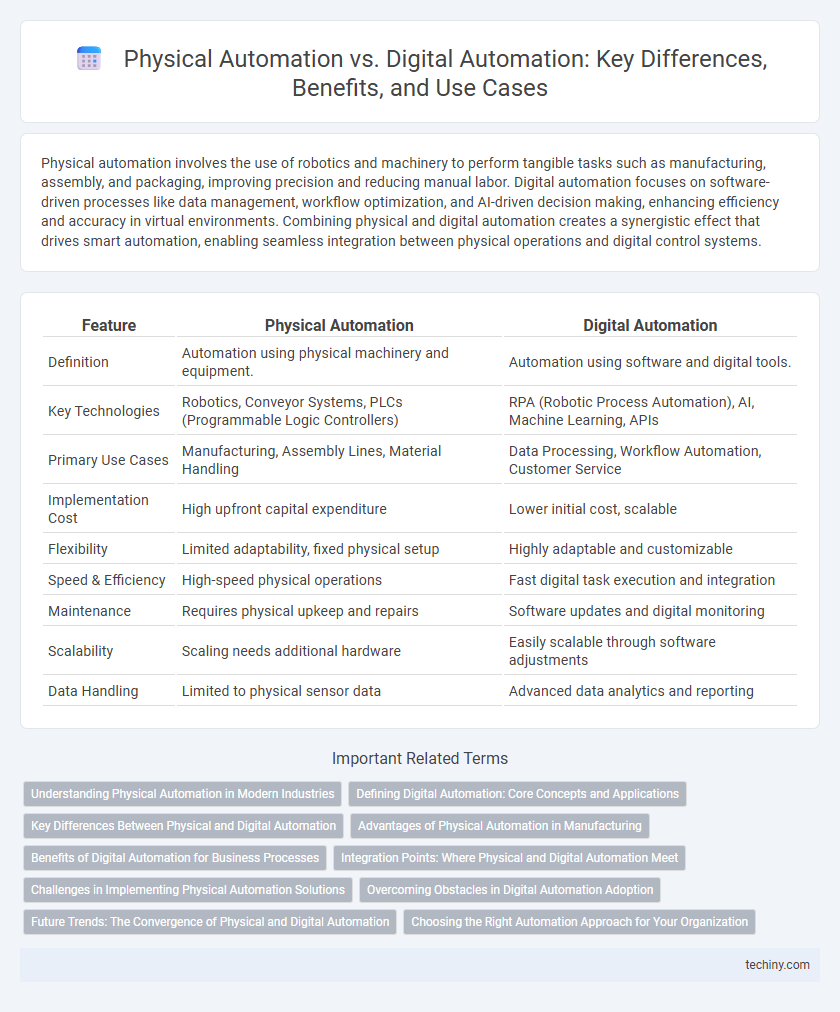Physical automation involves the use of robotics and machinery to perform tangible tasks such as manufacturing, assembly, and packaging, improving precision and reducing manual labor. Digital automation focuses on software-driven processes like data management, workflow optimization, and AI-driven decision making, enhancing efficiency and accuracy in virtual environments. Combining physical and digital automation creates a synergistic effect that drives smart automation, enabling seamless integration between physical operations and digital control systems.
Table of Comparison
| Feature | Physical Automation | Digital Automation |
|---|---|---|
| Definition | Automation using physical machinery and equipment. | Automation using software and digital tools. |
| Key Technologies | Robotics, Conveyor Systems, PLCs (Programmable Logic Controllers) | RPA (Robotic Process Automation), AI, Machine Learning, APIs |
| Primary Use Cases | Manufacturing, Assembly Lines, Material Handling | Data Processing, Workflow Automation, Customer Service |
| Implementation Cost | High upfront capital expenditure | Lower initial cost, scalable |
| Flexibility | Limited adaptability, fixed physical setup | Highly adaptable and customizable |
| Speed & Efficiency | High-speed physical operations | Fast digital task execution and integration |
| Maintenance | Requires physical upkeep and repairs | Software updates and digital monitoring |
| Scalability | Scaling needs additional hardware | Easily scalable through software adjustments |
| Data Handling | Limited to physical sensor data | Advanced data analytics and reporting |
Understanding Physical Automation in Modern Industries
Physical automation in modern industries involves the use of robotics, machinery, and mechanical systems to perform repetitive or hazardous tasks, enhancing efficiency and precision on manufacturing floors. This form of automation integrates sensors, actuators, and control systems to streamline production processes while reducing human error and labor costs. Industries such as automotive, electronics, and pharmaceuticals leverage physical automation to improve output quality and maintain consistent operational standards.
Defining Digital Automation: Core Concepts and Applications
Digital automation leverages software, artificial intelligence, and machine learning to optimize business processes, enabling real-time data processing and decision-making without human intervention. Core applications include robotic process automation (RPA), intelligent process automation (IPA), and workflow automation, which enhance efficiency by automating repetitive tasks and complex workflows across various industries. Unlike physical automation, which relies on mechanical systems and robotics, digital automation transforms information-based operations, driving scalability and agility in enterprise environments.
Key Differences Between Physical and Digital Automation
Physical automation involves the use of machinery and robotics to perform tangible tasks like assembly, packaging, or material handling, emphasizing hardware and mechanical systems. Digital automation centers on software-driven processes such as data management, workflow automation, and artificial intelligence integration, prioritizing virtual and cognitive functions. Key differences lie in their operational domains--physical automation automates physical work, while digital automation optimizes information processing and decision-making workflows.
Advantages of Physical Automation in Manufacturing
Physical automation in manufacturing enhances production efficiency by enabling precise, repeatable mechanical operations that reduce human error and increase output consistency. It leverages advanced robotics and machinery to perform heavy-duty tasks, improving workplace safety and minimizing physical strain on workers. This tangible automation directly integrates with hardware systems, facilitating real-time control and maintenance that optimize manufacturing workflows.
Benefits of Digital Automation for Business Processes
Digital automation enhances business processes by increasing accuracy and reducing operational costs through software-driven workflows. It enables real-time data integration and analytics, improving decision-making and agility in dynamic markets. Scalability and rapid deployment of digital solutions support continuous process optimization and greater overall efficiency.
Integration Points: Where Physical and Digital Automation Meet
Physical automation and digital automation converge at integration points such as IoT sensors, robotics, and cloud-based control systems that enable real-time data exchange. These touchpoints facilitate seamless coordination between automated machinery and software platforms through APIs, edge computing, and digital twins, enhancing operational efficiency. Effective integration leverages SCADA systems and AI-driven analytics to synchronize physical processes with digital workflows, driving smart manufacturing and Industry 4.0 initiatives.
Challenges in Implementing Physical Automation Solutions
Implementing physical automation solutions involves challenges such as high initial capital investment, complex integration with existing machinery, and the need for skilled personnel to maintain and operate automated systems. Physical automation also faces constraints related to space limitations, safety regulations, and adaptability to changing production demands. Addressing these challenges requires thorough planning, customized engineering, and ongoing training to ensure seamless operation and maximize return on investment.
Overcoming Obstacles in Digital Automation Adoption
Overcoming obstacles in digital automation adoption requires addressing data integration challenges, ensuring cybersecurity compliance, and providing workforce upskilling to handle new technologies. Physical automation focuses on mechanizing tangible processes, while digital automation streamlines workflows through software, necessitating distinct strategies for change management. Successful implementation depends on aligning IT infrastructure with business goals and fostering collaboration between technical teams and end users.
Future Trends: The Convergence of Physical and Digital Automation
Future trends in automation highlight the convergence of physical and digital automation, blending robotic machinery with AI-driven software for enhanced operational efficiency. This integration enables seamless data exchange between physical systems and digital platforms, driving smarter manufacturing, predictive maintenance, and real-time decision making. Leading industries adopting this hybrid approach include automotive, logistics, and smart manufacturing, positioning them for innovative advancements and competitive advantage.
Choosing the Right Automation Approach for Your Organization
Selecting the appropriate automation approach depends on organizational goals, existing infrastructure, and process complexity. Physical automation, involving robotics and machinery, suits manufacturing environments requiring precision and scalability, while digital automation leverages software tools such as RPA (Robotic Process Automation) and AI to optimize workflows and data-driven tasks. A hybrid strategy often maximizes efficiency by integrating physical hardware capabilities with digital process optimizations for comprehensive automation.
Physical Automation vs Digital Automation Infographic

 techiny.com
techiny.com